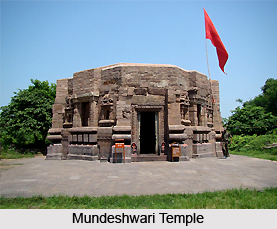 Mundeshwari Devi Temple, which is also known as, Mundesvari Temple, is located in Kaura of Kaimur District of Bihar. A large number of pilgrims visit the temple each year, particularly during the Ramnavami, Shivaratri festivals. A big yearly fair is held near the Mundeshwari Devi Temple during the Navaratri Festival visited by thousands.
Mundeshwari Devi Temple, which is also known as, Mundesvari Temple, is located in Kaura of Kaimur District of Bihar. A large number of pilgrims visit the temple each year, particularly during the Ramnavami, Shivaratri festivals. A big yearly fair is held near the Mundeshwari Devi Temple during the Navaratri Festival visited by thousands.
Mundeshwari Devi Temple is an age-old temple with historical and archaeological importance. Mundeshwari Devi Temple is located in a solitary place called Mundeshwari hills. Mundeshwari Devi Temple is dedicated to Lord Shiva and Shakti. This temple is considered as an ancient temple in Bihar and in the world.
The inscriptions that found in Mundeshwari Devi Temple by Archaeological Survey of India indicated that this temple was built in 108 AD. Some historians claim that Mundeshwari Devi Temple was built in Saka Era or during the rule of Gupta Empire in India. Archaeological Survey of India now maintains this temple.
Mundeshwari Devi Temple was built out of stone, is on an octagonal plan, which is rare. It is the earliest specimen of the Nagara style of architecture in Bihar. There are doors or windows on four sides and small niches for the reception of statues in the remaining four walls.
The temple "Shikhara" or tower has been destroyed. However, a roof has been built, as part of renovation work. The interior walls have niches and bold mouldings, which are carved with vase, and foliage designs. At the entrance to the temple, the doorjambs are seen with carved images of Dwarapalas, Ganga, Yamuna and many other Hindu deities. The main deities in the sanctum sanctorum of the temple are of the Goddess Mundeshwari and the four faced Shiva lingam.
Even though the Shiva linga is installed in the centre of the sanctum, the main presiding deity is Devi Mundeshwari deified inside a niche, which is seen with ten hands holding symbols riding a buffalo, attributed to Mahishasuramardini.
The temple also has the idols of other popular gods such as Lord Ganesha, Lord Surya and Lord Vishnu. A substantial part of this 7th-century stone structure has been damaged, and many types of stone wreckage are seen scattered around the temple.





















